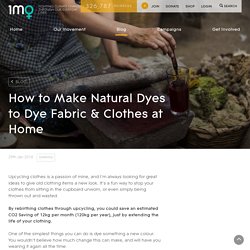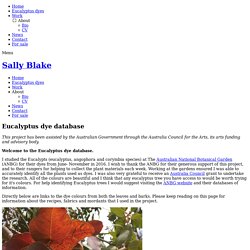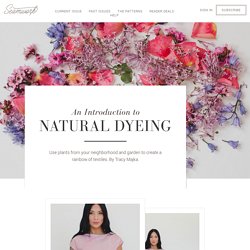

Lizzie Godden - Dead heading daffodils! Los Angeles Times. Seamwork Magazine. From crushed bugs to cow urine: the history of colours – in pictures. How to Make Natural Dyes to Dye Fabric & Clothes at Home. Upcycling clothes is a passion of mine, and I'm always looking for great ideas to give old clothing items a new look.

It's a fun way to stop your clothes from sitting in the cupboard unworn, or even simply being thrown out and wasted. By rebirthing clothes through upcycling, you could save an estimated CO2 Saving of 12kg per month (120kg per year), just by extending the life of your clothing. One of the simplest things you can do is dye something a new colour. You wouldn't believe how much change this can make, and will have you wearing it again all the time. However, there is just one problem with this. But don't worry, because I have a great alternative for you! I have experimented a lot with using natural dyes, and it's a really fun and rewarding process especially the end result. 1. Any light-coloured (preferably white) natural fibers will take natural dyes. 2.
Something extremely cool about natural dyes is that many of the ingredients could be found right in your own back yard! Bridgetown.com. Eco Dyeing Christine Latham 7 December 2015 Bridgetown Pottery Restaurant Cost $45 Materials $10 for silk scarf (if using) Three hours of science, magic and fun is called Eco dyeing.

You will be shown actual examples of Eco dyeing, see photos of previous beginners works and be given notes to continue at home. You will participate in methods of folding and bundling, dyeing silk, muslin and paper with such things as eucalyptus leaves, Sheoak needles and rusty nails, all brewed in pre prepared dye baths for several hours, left overnight to cool, then unwrapped and revealed the next day. Eco-dyeing: Capturing the colours of country with Kay Lee Williams. NITV: You've been working on textiles, including scarves, for several years.

How long have you been creating these scarves? Kay Lee Williams: I’ve been doing scarves since around 2012, so not long really. Unfortunately I work full time, so at times don't get a lot of time to do as much as I would like. Where did you find out about eco-dyeing? Initially my niece showed me how to eco dye. It's interesting how different tutors show various methods, but I adjust and am always experimenting. What plants do you use for the dyeing process? I use a variety of gum tree leaves among other flowers and their leaves such as grevilleas, roses, kangaroo paw. Some come out red, green, spotted black, and it always amazes me the various shades I get. What is the gathering process like? Eucalyptus dyes — Sally Blake. Recipes For the project I used the same recipe for every dye-pot so results from the different plants could be compared.

Below I have outlined the specific recipes for this project. However if I am making dyes to colour materials for artworks my recipe wouldn't need to be so precise. Basically I use a non-reactive (stainless steel) pot big enough to hold the materials to be dyed. Next I would nearly fill the pot with leaves and then add water until the leaves are covered. Project recipes The leaves- from each species I removed 100 grams of leaves from the stalks and flower buds. With the dye liquor onlywith alum as a mordant iron as a mordantcopper as a mordant. Indigo dye discovered in 6,000-year-old textiles from Peru - Science News. Posted The blue indigo dye commonly used in today's jeans was used by pre-Hispanic communities in Peru around 6,000 years ago.

Key points Well-preserved, 6,000-year-old cotton fabric from Peru contains indigo dyeDiscovery pushes back earliest known use of indigo by 1,500 yearsFinding suggests pre-Hispanic communities were very sophisticated Their use of the complex technique involved in creating indigo dye predates its use by ancient Egyptians by about 1,500 years. The finding, published in Science Advances, is based on the analysis of blue pigment in a 6,000-year-old piece of cotton fabric found at an archaeological site in Huaca Prieta, on the north coast of Peru.
The source of the blue pigment was unknown until today's study, which used highly sensitive equipment known as high-performance liquid chromatography to determine it was a plant-based form of indigo. "This discovery demonstrates that their history deserves more attention," he added. Making Natural Dyes from Plants. Did you know that a great source for natural dyes can be found right in your own back yard!

Roots, nuts and flowers are just a few common natural ways to get many colors. Yellow, orange, blue, red, green, brown and grey are available. Go ahead, experiment! Gathering plant material for dyeing: Blossoms should be in full bloom, berries ripe and nuts mature. Remember, never gather more than 2/3 of a stand of anything in the wild when gathering plant stuff for dying. To make the dye solution: Chop plant material into small pieces and place in a pot. Getting the fabric ready for the dye bath: You will have to soak the fabric in a color fixative before the dye process. Dyeing Fabric with Fruit An Introduction to Natural Dyeing Choosing Your Plants Begin by looking at what you already have in your own backyard or outdoor space.

Any plant you have a lot of will most likely produce some color in the dyepot. Generally, the more plant material you have, the more you can add to the pot, and the more concentrated your dye will be. You can use just one type of plant in the dyepot or a mix. This year, I plan to try dyeing with wild bergamot and evening primrose—I have no idea how viable they are as dye plants, but we sure do have a lot of them. A couple things to keep in mind: Make sure the plant is safe to handle and work with. Guest Post: Natural Dye Tutorial from Argaman & Defiance - Madalynne - The Cool Patternmaking and Sewing Blog. How to Dye Fabric Pink Naturally - Cherries. Making Natural Dyes from Plants.